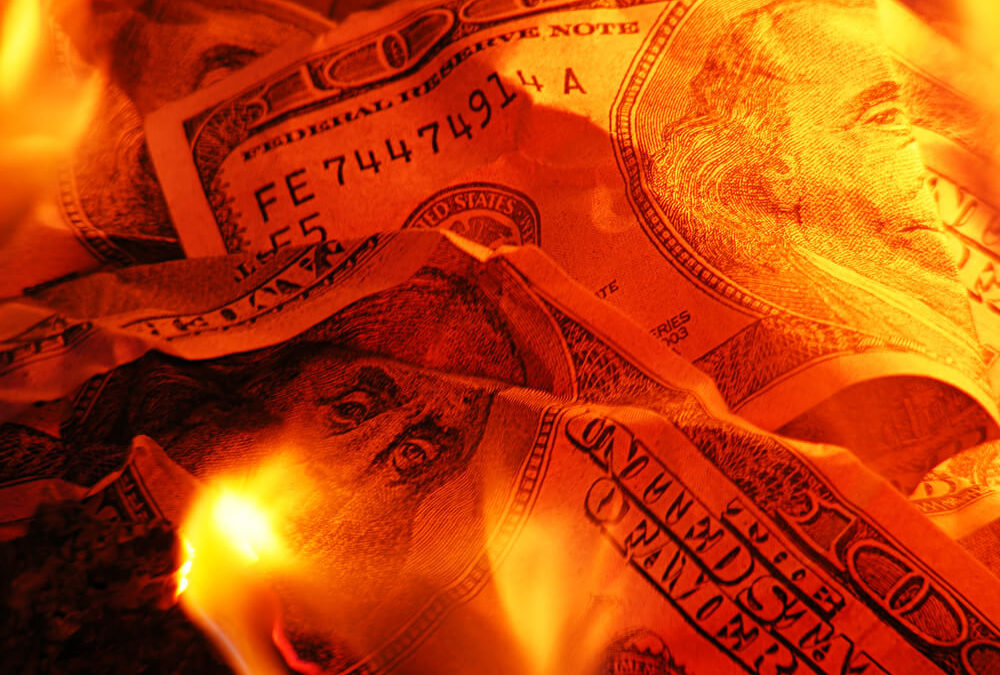SAN MARTIN, ARGENTINA — A horseman suddenly appeared in the field in front of us. He was riding hell for leather to the south.
A real gaucho, completely at ease… as if he and the horse were one animal… lithe… agile… graceful…
“What’s going on…” Elizabeth wondered. “That’s Pablo… and he’s on that Criollo… He’s really flying…”
A few hundred yards away, we saw what he was after. A wild burro, or donkey, had gotten into the hay field and was eating one of the round bales.
There are hundreds of burros in the hills. Like deer in Maryland and guanaco up at the ranch, they are a nuisance. Occasionally, hunting parties are organized to kill them.
Back in the ’60s, someone had the idea of turning the burro into a farm animal. He raised them, slaughtered them, and made the meat into a kind of spam… or pâté. He called it Buro!
“They sold a lot of it in the city,” explained Ramón. “I don’t think the city folks understood what was in it. It sold well for a while, but I haven’t seen it in a long time.”
Our farm is well fenced. But when the water goes down in the river, the burros can get across. Occasionally, they show up in the pastures.
Pablo raced toward the burro. Behind him, a black dog ran as fast as he could, trying to keep up.
Seeing him coming, the burro began running in the opposite direction. But the burro was no match for the criollo. The horse easily outpaced him… and cut him off each time he tried to escape.
By then, the dog was on the job, too. He knew what to do. He circled… yapped at the burro…
Dogs are useful for herding animals. But they are not necessarily good at keeping them in one place; they frighten and annoy them.
Pablo dismounted. He got down his lasso. But while he was thus occupied, the burro bolted.
In a half a second, Pablo was back on his horse. But this time, rather than try to capture the burro, he and the dog drove it forward… all the way up to the gate.
The animal passed through the gate, Pablo dismounted… and closed it. Then, he got back on his horse, waved his hat in the air… and with a shout, drove the burro back across the river.
Meanwhile, Elizabeth had turned to look in the other direction.
“I think the house is on fire,” she said.
But we’ll come back to that in a minute.
Let’s first turn to the coming economic, political and social ruin of America…
A Page From Argentina’s Book
There’s an advantage to spending time in a place like Argentina. It’s been through these things before. In fact, it makes a habit of it. Here’s the latest from Yahoo Finance:
Argentina said it didn’t make $500 million in debt payments due Wednesday, starting a 30-day countdown to a possible default unless the government and bondholders can reach a deal on restructuring its massive foreign debt.
Bloomberg tells us what happens next:
Since the country is cut off from credit markets… it can’t borrow to fund stimulus programs, as other countries in the region are doing. Instead, the central bank is emitting massive amounts of money to cover government programs, threatening to drive up an inflation rate that is already among the highest in the world.
Since the lockdown was announced March 19, the monetary base has increased about 20%, with the central bank sending 340 billion pesos ($5.2 billion) to the government during that time as dividends and temporary transfers.
That’s causing the peso to lose value as companies and wealthy citizens try to convert excess pesos into the safe haven of U.S. dollars.
Can you imagine doing anything so stupid? Covering current expenses by printing money? Allowing your money supply to increase by 20% in just a month?
These gauchos… what a bunch of dummies. That’s why economists like to study Argentina. It’s the only country in the world to go from one of the world’s richest… to crap hole status… thanks entirely to government policy.
But wait…
…you say the U.S. is printing money to cover its operating expenses, too? The budget this year is exploding to $7 trillion.
Tax receipts were only expected to be in the neighborhood of $3.8 trillion — and that was before the coronavirus hit. Now, it’s tough to say… maybe only $3 trillion… maybe only $2 trillion.
That means the feds will have to borrow. But who’s got $4 trillion?
The Argentines can’t borrow because no one will lend them money. The Americans can’t borrow, either, because nobody’s got that kind of money. And if they had it, they wouldn’t be fool enough to lend to someone on such a reckless spending binge.
The only possible source for so much financing is the Federal Reserve. And the Fed’s only source is the “printing press.” So, in other words, the U.S. is following in Argentina’s tracks… but on a much bigger scale.
But wait… you say the Fed is adding to the money supply… just like Argentina?
The first week of March, the Fed held assets of $4.29 trillion, mostly U.S. Treasuries. Now, it has about $6.36 trillion worth, all of it bought with “printing press” money. That is an increase of… are you ready for this… 48% — or more than twice as fast as Argentina.
Bad Memories
Argentina’s inflation rate is already over 50%. But that’s nothing compared to its inflation of the 1980s.
Anyone over the age of 40 can remember when prices rose an average of about 300% per year.
That kind of inflation does to an economy approximately what the coronavirus does.
Things shut down. Businesses can’t make plans. They can’t invest for the future. They let workers go. People stay home. Their money loses value so fast, they try to get rid of it as soon as possible. This feeds even further price increases… and less production.
Typically, the government proposes scapegoats… enemies… and jackass solutions — all of which make things worse.
Price controls, for example, discourage the little output that was left. High taxes and capital restrictions drive away investors. And wars — meant to distract people from the financial mismanagement and rally them behind the government — waste the little wealth that is still available.
Monetary Madness
When it comes to making a mess of an economy, the Argentines are pros.
In 1982, the military dictatorship went to war with Britain. That was a disaster.
Inflation soared as the government tried to pay its expenses with printing-press money. By the following year, it had to issue a “new peso,” worth 10,000 old pesos.
When that failed to stop inflation, in 1985, another currency appeared — the austral — which was traded in at the rate of one per 1,000 pesos.
Of course, changing the currency did nothing to halt inflation. As long as the government was funding itself with printing-press money, people didn’t care whose picture was on it.
By 1989, the inflation rate hit 12,000%. Riots broke out in the streets.
Finally, the austral was tossed onto the monetary trash heap and a new “convertible” peso was introduced. One new peso was equal to 10,000 australes.
Convertibility was the key. The new currency was linked to dollars. And for a time, this worked reasonably well. Inflation almost disappeared. The economy began a rebound.
We remember well when this period of relative stability and prosperity came to an end. Because we happened to have a meeting with Argentine president Carlos Menem.
We were with a group of investors. We knew the “convertibility” system was under pressure. As usual, the government had spent too much money.
But if it abandoned the “dollar peg,” all hell would break loose… with another default, devaluation, inflation… and all the other problems the Argentines know so well.
So we put the question to Señor Menem directly. “Will Argentina abandon its peso-dollar link?”
“No, definitely not,” came the reply. “We depend on it. Our economy needs it. Foreign investors require it. We will never give it up.”
Three weeks later, the convertible peso was history… and Argentina was on another wild ride of monetary madness.
Banks were closed. Dollar deposits were forcibly converted to pesos… and savers lost two-thirds of their money immediately.
Since then, it has been downhill. From one-to-one convertibility in 1991, you can get 90 pesos per dollar today, on the black market.
“Here in Argentina, we know we’re crazy,” says our neighbor, Ramón. “Now, we’re glad to have company.”
Fire in the Valley
Meanwhile, smoke was billowing from our office roof. And in front stood Monzon… a mountain of a man, grinning.
Everything about Monzon is big. His head. His hands. His smile.
He was raising the roof of a barn across the river when the quarantine struck. Since it is a farm building, he’s been allowed to continue.
During the week, he stays here, sleeping in a shed and cooking over an open fire. On weekends, he goes home to a nearby village. Often, he gets drunk and doesn’t come back until Tuesday.
We had asked him to come over and take a look at our fireplace. It’s our only source of heat. But it smokes badly. And cold weather is coming.
“Monzon, you’ve set our house on fire!”
“No, patron, I just cut a hole in the roof and lit a fire to see how the smoke would rise. And now I see what is wrong. I’ll fix it.”

Monzon and a helper fixing the chimney.
Regards,
Bill
• This article was originally published by Bonner & Partners. You can learn more about Bill and Bill Bonner’s Diary right here.




